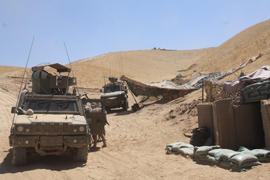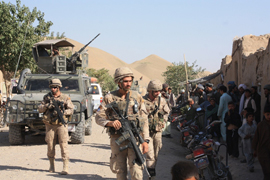- Home
- International Missions
- Afghanistan
- ASPFOR XXXI
ASPFOR XXXI



The 31st Spanish Force for Afghanistan, ASPFOR XXXI, is an operational organisation made up of personnel from different Armed Forces and Civil Guard units, although its main contributor is the Army. Most of its troops come from the 6th Parachute Brigade “Almogávares”. The head of ASPFOR XXXI is Luis Cebrián Carbonell.
ASPFOR XXXI is stationed at the Provincial Support Base (PSB) “Ruy González de Clavijo” in Qala-i-Naw, capital of the Badghis province. There are 1,202 permanent personnel, of whom 4% are female and 7%, foreign nationals.
Length of the mission
On 22 May 2012 took place an official farewell ceremony to see off the troops at the Santa Bárbara garrison, HQ of the 3rd Parachute Battalion “Ortiz de Zárate”, in the town of Javalí Nuevo (Murcia). Deployment in the area of operations started right after the ceremony and lasted until the end of June.
The Transfer of Authority (TOA) ceremony took place in the morning of 14 June at the base “Ruy González de Clavijo”. Colonel Cebrián received the unit’s flag from Italian General Luigi Chiapperini, chief of the International Security Assistance Force’s Regional Command West (ISAF RC-West), to symbolise the handover of responsibility.
TAO to ASPFOR XXXII is scheduled for 11 November, when the 7th Light Infantry Brigade “Galicia” will take the baton from the 6th Parachute Brigade “Almogávares”.
Structure and deployment
ASPFOR XXXI has its HQ at the PSB “Ruy González de Clavijo” in the town of Qala-e-Naw, capital of the Badghis province.
The force is structured into four different bodies, according to the task they perform: The Provincial Reconstruction Team (PRT); the task force “TF Badghis”; the operational mentor and liaison teams to the Afghan army and police (OMLTs and POMLTs, respectively); and the enabling and support units. The latter guarantee that the others are fully operational and their needs are covered.
Some members of ASPFOR XXXI are stationed at the Forward Staging Base “Camp Arena”, near the city of Herat, the capital of the region. They include a rear-guard logistic unit and a liaison officer.
Provincial Reconstruction Team (PRT)
A PRT is a civil-military organisation able to operate in unstable and dangerous areas. It combines diplomatic and military capabilities to create a safe environment and bolster the efforts of the Afghan government by improving the situation of the population and supporting reconstruction and development programmes. Spain contributes the PRT in the Badghis province.
ASPFOR XXXI contributes the military component of the PRT structure, which includes a Protection & Security Unit; a Civil-Military Cooperation Unit from the CIMIC Battalion based in Valencia; and a Psychological Operations Unit from the 1st Intelligence Regiment, also based in Valencia.
The PRT’s civilian component is charged with identifying, assessing and executing projects with a significant social and economic impact which carry direct and long-term benefits for the province. Those projects focus on areas such as basic infrastructures, water and sanitation, health, education, women’s rights, agriculture and animal husbandry.
The head of the PRT is a career diplomat who also acts as a political advisor (POLAD) to the civil-military organisation. He is assisted by personnel from the Spanish Agency for International Development Cooperation, which is under the authority of the Spanish Ministry of Foreign Affairs.
TF Badghis Regiment
Task Force Badghis is composed of personnel from the 3rd Parachute Battalion “Ortiz de Zárate”, based in Javalí Nuevo (Murcia). Its main task is to provide a safe environment so that the Afghan people and all other national and international actors can work in the province without harm or hindrance.
Regarding deployment, the task force operates in three different areas in the Badghis province: Qala-i-Naw, where it provides security, takes part in controlling the airport and keeps a reserve unit; and the Combat Outposts (COPs) “Bernardo de Gálvez II”, in Ludina, and “Ricketts”, in Muqur, which guarantee freedom of movement through the “Lithium” and “Ring Road” routes respectively.
Mentor & Liaison Teams (OMLTs, POMLTs/PATs & MATs)
The Operational Mentor & Liaison Teams (OMLTs) are composed of personnel from the Parachute Brigade, Field Artillery Command, Balearic Islands General Command and the Marine Infantry Regiment. Their tasks include organising, supporting, training, advising, liaising with and supervising the Afghan army and police. All of them fall within the scope of the general definition of “mentoring”. Their work method is based on the technique “shobna ba shohna” (in Dari, “shoulder to shoulder”).
For its part, and following the same model, the Civil Guard contributes the Police Operational Mentor & Liaison Teams (POMLTs) which mentor provincial police HQ and the policemen and women of the district.
Given that the Afghan police has reached a level of training considered satisfactory, the POMLT teams have been renamed PATs, Police Advisory Teams. The idea is that they no longer require training, only supervision.
Similarly, the training of military units is being replaced by advising, which is the role of the Military Advisory Teams (MATs). Their organisation is similar to that of the mentoring teams and their members come from Field Artillery Command. In the final phase it is envisaged that the Afghan army will be able to operate completely autonomously.
Enabling and support units
These highly specialised units work alongside the PRT, TF Badghis and the MATs/PATs, and their contribution is crucial to the mission. They include the Sappers Unit, the Signals Unit, the Medical Support Unit, the Main Logistic Unit and the Advanced Aerial Group, in addition to the Base Support Unit, whose role is essential for the others.
These units provide the combat and logistic support necessary to guarantee a successful outcome and must therefore be included in all planning.
Challenges facing ASPFOR XXXI
The main challenges facing ASPFOR XXXI are:
- Maintaining and extending security in the Badghis province in collaboration with the Afghan army (ANA) and the Afghan police (ANP).
- Continuing the paving of the “Lithium” road to Mangan to ensure freedom of movement between Qala-i-Naw and Bala Murghab in the near future.
- Upgrading the capabilities of the Afghan army and police in matters of defence and security, so that they are able to assume their responsibilities within the set deadlines.
- Increasing support to the governability of the Badghis province through the development programmes already underway, especially the state-wide programme to reintegrate insurgents.
ARMY UNITS
- Araba Álava |
- Albacete |
- Alicante |
- Almería |
- Asturias |
- Ávila |
- Badajoz |
- Barcelona |
- Burgos |
- Cáceres |
- Cádiz |
- Cantabria |
- Castellón |
- Ceuta |
- Ciudad Real |
- Córdoba |
- A Coruña |
- Cuenca |
- Girona |
- Granada |
- Guadalajara |
- Gipuzkoa |
- Huelva |
- Huesca |
- Islas Baleares |
- Jaén |
- León |
- Lleida |
- Lugo |
- Madrid |
- Málaga |
- Melilla |
- Murcia |
- Navarra |
- Ourense |
- Palencia |
- Las Palmas |
- Pontevedra |
- La Rioja |
- Salamanca |
- Segovia |
- Sevilla |
- Soria |
- Tarragona |
- Santa Cruz de Tenerife |
- Teruel |
- Toledo |
- Valencia |
- Valladolid |
- Bizkaia |
- Zamora |
- Zaragoza



